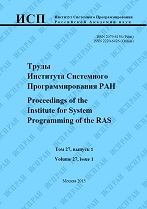|
Protocol automata recovery method using binary code
I. V. Sharkov
Ivannikov Institute for System Programming of the RAS
Abstract:
Security analysis of network programs includes set of reverse engineering tasks of network protocols. Data formats restoring and implemented protocol automaton are the previous task issues. Unlike quite researched problem of formats restoring where there are lots of scientist’s papers, finding out the protocol's automaton program implementation looks like terra incognita and the cornerstone is a protocol state description currently undefined. There are two general ways to retrieve the implemented protocol automaton: an analysis of the network traces and looking into binary trace of the target application. This article offers a second one method. The first aim of the paper is the way to describe a mathematical model of a protocol automaton and a method for projecting it onto an executing application binary code. The second is concept of the protocol state definition and a principle to detect the states transitions based on some "global" binary trace objects, are described. Thirdly, there is suggested a protocol automaton precising manner by in-memory fuzzing based on a "floating" fork-server to manage states transitions. Finally, developed toolset's scheme and experiments on its using with a real VPN client, are shown.
Keywords:
network protocol, protocol automata, state, binary code, fuzzing
Citation:
I. V. Sharkov, “Protocol automata recovery method using binary code”, Proceedings of ISP RAS, 34:5 (2022), 43–62
Linking options:
https://www.mathnet.ru/eng/tisp720 https://www.mathnet.ru/eng/tisp/v34/i5/p43
|

| Statistics & downloads: |
| Abstract page: | 45 | | Full-text PDF : | 27 |
|




 Contact us:
Contact us: Terms of Use
Terms of Use
 Registration to the website
Registration to the website Logotypes
Logotypes









 Citation in format
Citation in format 